Marimba
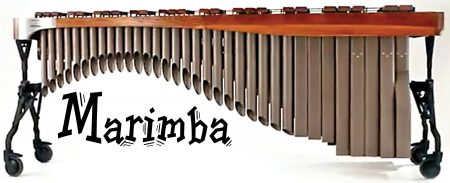 By Nancy Buchan
By Nancy Buchan
Last month the president of Costa Rica, Luis Guillermo Solis, attended a celebration at a school in the Nicoya—an area, along with Guanacaste, that is somewhat known for the making and playing of marimbas. He was treated to some local students playing their marimbas, and then he designated November 30th the Day of the Marimba! Now maybe you don’t think that this is particularly big news, but I think this humble yet mighty instrument deserves a day of its own to be honored. It’s already the national instrument of Guatemala and of Nicaragua, so why shouldn’t CR get on the band wagon! The marimba has inspired political diatribes, survived governmental bans and modern updating, and it is still a unique and beautiful sounding traditional instrument that is very popular throughout Central America.
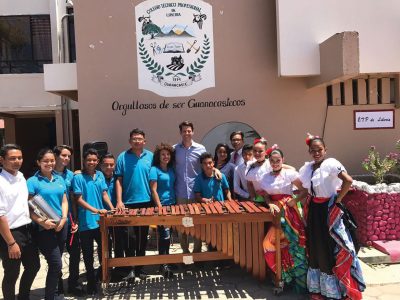 Music historians believe that the earliest form of the marimba originated in Africa, but there is evidence of their existence in the Americas from pre-hispanic (Mayan) times. Vases and cave art have been found showing ancient Mayans carrying and playing a similar looking instrument, and it is believed to be a descendent of the tepomanstle, a scared ceremonial Mayan drum. The Spaniards, of course, banned the instrument, since it was an important part of the Mayan traditions they were trying to eradicate, but the indigenous people reacted by hiding them and constructing them in secret. Africans had an instrument much like the marimbas of the Mayans, as do the Basque people of Spain and the gypsies who migrated from India. Vietnamese people have their own version, called a Dan Da, made from different sized stones suspended over strings and hit with stone or metal hammers. Not very mobile but an interesting sound and concept.
Music historians believe that the earliest form of the marimba originated in Africa, but there is evidence of their existence in the Americas from pre-hispanic (Mayan) times. Vases and cave art have been found showing ancient Mayans carrying and playing a similar looking instrument, and it is believed to be a descendent of the tepomanstle, a scared ceremonial Mayan drum. The Spaniards, of course, banned the instrument, since it was an important part of the Mayan traditions they were trying to eradicate, but the indigenous people reacted by hiding them and constructing them in secret. Africans had an instrument much like the marimbas of the Mayans, as do the Basque people of Spain and the gypsies who migrated from India. Vietnamese people have their own version, called a Dan Da, made from different sized stones suspended over strings and hit with stone or metal hammers. Not very mobile but an interesting sound and concept.
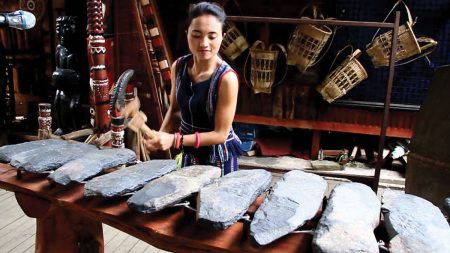 Marimbas are basically a row of wooden slats in different lengths which are laid over wooden tubes to enrich and amplify the tone, which is produced by hitting them with wooden mallets or hammers. In earlier times the builders would use hollowed out gourds as the resonators, and the slats were made from rosewood, cocobolo, cristobol or some other hardwood available in their habitat. The keyboard would be mounted on some kind of frame to put it about waist high, with the longer bars on the left producing the lower notes with gradually shorter slats on the right to hit the higher notes. Most have 24 keys (bars, slats, whatever…), representing three octaves, but bigger ones can have up to 73 keys. The original instrument played a basic diatonic scale, kinda like playing the white keys on a piano. At some point in the 1890s another layer of slightly elevated wooden keys were put in the spaces where the black keys would exist on a piano, making it into a chromatic scale instrument. Many jazz musicians play a more modern version of the marimba, called a xylophone or a vibraphone, made mostly from metal and using electronic amplification. Both types of instruments can be played with as many mallets as the musician is capable of being accurate with—two mallets in each hand is typical but real show-offs will use more.
Marimbas are basically a row of wooden slats in different lengths which are laid over wooden tubes to enrich and amplify the tone, which is produced by hitting them with wooden mallets or hammers. In earlier times the builders would use hollowed out gourds as the resonators, and the slats were made from rosewood, cocobolo, cristobol or some other hardwood available in their habitat. The keyboard would be mounted on some kind of frame to put it about waist high, with the longer bars on the left producing the lower notes with gradually shorter slats on the right to hit the higher notes. Most have 24 keys (bars, slats, whatever…), representing three octaves, but bigger ones can have up to 73 keys. The original instrument played a basic diatonic scale, kinda like playing the white keys on a piano. At some point in the 1890s another layer of slightly elevated wooden keys were put in the spaces where the black keys would exist on a piano, making it into a chromatic scale instrument. Many jazz musicians play a more modern version of the marimba, called a xylophone or a vibraphone, made mostly from metal and using electronic amplification. Both types of instruments can be played with as many mallets as the musician is capable of being accurate with—two mallets in each hand is typical but real show-offs will use more.
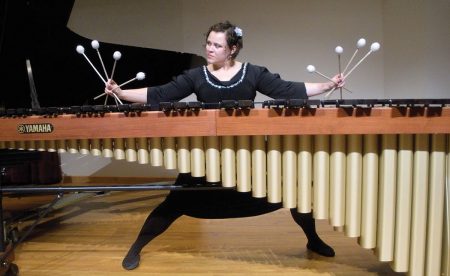 For many marimba players or builders it’s a family affair. Everyone learns how to craft, tune and play the instruments, knowing that there’s a steady Saturday night gig down the road if you can just keep enough kinfolks interested. A typical marimba band would have a bass, drums, and two or three marimbas, with maybe two people playing on one of the larger instruments. Unfortunately there is a bit of a current crisis in the marimba world, as the wonderful and skillful old guys who make these instruments are dying off. Hopefully the younger generations will discover how cool these instruments are and will take the time to learn the techniques and craft of building them. To make a nice instrument takes from three to six months, not counting the acquiring of and aging of the wood to be used.
For many marimba players or builders it’s a family affair. Everyone learns how to craft, tune and play the instruments, knowing that there’s a steady Saturday night gig down the road if you can just keep enough kinfolks interested. A typical marimba band would have a bass, drums, and two or three marimbas, with maybe two people playing on one of the larger instruments. Unfortunately there is a bit of a current crisis in the marimba world, as the wonderful and skillful old guys who make these instruments are dying off. Hopefully the younger generations will discover how cool these instruments are and will take the time to learn the techniques and craft of building them. To make a nice instrument takes from three to six months, not counting the acquiring of and aging of the wood to be used.
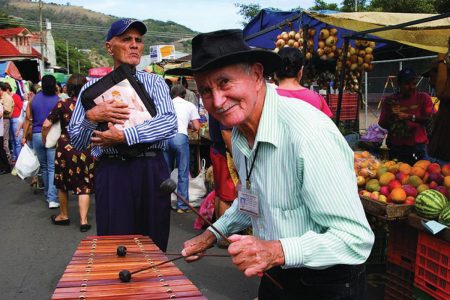 A fairly recent adaptation is a more mobile version made by bending and shaping bamboo for the frame—it can be taken apart into two sections for easy transport and the musician sits on part of the frame to hold it in place—eliminating the need for a stand. Very clever design and it has a quite lovely sound and appearance. Every night I would watch the marimba guys fussing with their instruments and preparing for a performance, but I never really focused on what they were doing. I figured they had their own version of tuning, or rosining their bow, or cleaning some part or whatever musicians like them did before a gig. I finally asked Manuel Obregon about it, and he said they were applying new thin hog liver skin across the bottom of the resonator tubes to produce a better tone. They would also cover a small hole carved in the tubes with sheepskin, using beeswax as an adhesive. This would add a bit of a buzz or rattle to the tone—a sound called ‘charleo’. What a great example of a creative mind using the options available to them in a rural environment! Pretty cool.
A fairly recent adaptation is a more mobile version made by bending and shaping bamboo for the frame—it can be taken apart into two sections for easy transport and the musician sits on part of the frame to hold it in place—eliminating the need for a stand. Very clever design and it has a quite lovely sound and appearance. Every night I would watch the marimba guys fussing with their instruments and preparing for a performance, but I never really focused on what they were doing. I figured they had their own version of tuning, or rosining their bow, or cleaning some part or whatever musicians like them did before a gig. I finally asked Manuel Obregon about it, and he said they were applying new thin hog liver skin across the bottom of the resonator tubes to produce a better tone. They would also cover a small hole carved in the tubes with sheepskin, using beeswax as an adhesive. This would add a bit of a buzz or rattle to the tone—a sound called ‘charleo’. What a great example of a creative mind using the options available to them in a rural environment! Pretty cool.
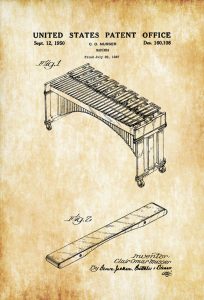 Years ago two non-governmental agencies (Costa Ricas’ ONG and Hollands’ HEBOS) funded a project intended to foster better relations between Nicaragua and Costa Rica, who historically have always found something to argue about. The idea was to have CR pianist and composer Manuel Obregon audition and rehearse with rural marimba players for a collaborative performance to illustrate how musical cooperation and respect between different cultures can be achieved. They recorded a cd together called “Pasion”, which is unfortunately out of print, but they ended up having unexpected success and toured Central America, the US and Europe. I met them when we brought the Papaya Orquesta to the Jazz Fest in New Orleans—with three Nicaraguan marimba players who had never been much farther from their homes than the next town… I’ll never forget the looks of astonishment and fear when they first saw Bourbon Street—or their happiness when we finally found a Mexican restaurant where they could eat beans and rice without Cajun hot sauce. I later played with several of the same family members in Manuel’s project Orquesta del Rio Infinito, and they are all still collaborating and creating great music together. Music is a powerful way to unite people!
Years ago two non-governmental agencies (Costa Ricas’ ONG and Hollands’ HEBOS) funded a project intended to foster better relations between Nicaragua and Costa Rica, who historically have always found something to argue about. The idea was to have CR pianist and composer Manuel Obregon audition and rehearse with rural marimba players for a collaborative performance to illustrate how musical cooperation and respect between different cultures can be achieved. They recorded a cd together called “Pasion”, which is unfortunately out of print, but they ended up having unexpected success and toured Central America, the US and Europe. I met them when we brought the Papaya Orquesta to the Jazz Fest in New Orleans—with three Nicaraguan marimba players who had never been much farther from their homes than the next town… I’ll never forget the looks of astonishment and fear when they first saw Bourbon Street—or their happiness when we finally found a Mexican restaurant where they could eat beans and rice without Cajun hot sauce. I later played with several of the same family members in Manuel’s project Orquesta del Rio Infinito, and they are all still collaborating and creating great music together. Music is a powerful way to unite people!
If you find out that a marimba band or soloist is playing in your neighborhood, go check out this most interesting and beautiful sounding instrument. Or google marimba on the internet and listen to the many options available. It has a long history and influence—don’t wait until Dia de Marimba next November to educate yourself! As always, I encourage you folks to get out and listen to LIVE LOCAL MUSIC! BEN JAMMIN’ and the HOWLERS play most Friday nights at the beautiful and spacious ROCA VERDE Restaurant and Bar, just south of Dominical, and at La Palma Beach Club on Thursdays. A different version of the HOWLERS play Wednesdays at DOS LOCOS in Quepos, where they also have live acoustic type music on Saturday afternoons. There are several excellent new venues down here in Dominical that are featuring live music, check out country music great RALPH SIMMS playing around town, and search out the excellent local Latin musicians here—get out and have some fun supporting the venues that support us!
Music is everybody’s possession. It’s only publishers who think that people own it. John Lennon
I love to sing, and I love to drink scotch. Most people would rather hear me drink scotch. George Burns
From there to here, and here to there, funny things are everywhere. Dr. Seuss
Go to Heaven for the climate, Hell for the company. Mark Twain

As a percussion performance major at Berklee College of Music in Boston, I was required to take marimba lessons as part of the curriculum. I must confess I was no good at it, but the warm resonance and tone of the wood keyboard is a sound you must hear in person to truly appreciate. You literally “feel” the notes vibrate through your body and I have always found it the most beautiful sound of the percussion family. Not as easy as it may look, it requires keyboard and drumming skills simultaneously. Thanks for sharing the history of this often forgotten instrument Nancy Buchan.